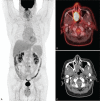Recurrence of nasal type NK/T cell lymphoma presenting as neurolymphomatosis on 18F-FDG PET/CT: A case report and literature review
- PMID: 31895825
- PMCID: PMC6946263
- DOI: 10.1097/MD.0000000000018640
Recurrence of nasal type NK/T cell lymphoma presenting as neurolymphomatosis on 18F-FDG PET/CT: A case report and literature review
Abstract
Introduction: NK/T cell lymphomas seldom involve the peripheral nervous system. We report a case of recurrent nasal type NK/T cell lymphoma presenting as neurolymphomatosis and its manifestation on F-FDG PET/CT.
Patient concerns: A 55-year old man presented with a mass in the right nasal cavity was diagnosed with extranodal NK/T cell lymphoma, nasal type. F-FDG PET/CT showed intense FDG uptake within the mass. After radiotherapy the nasal tumor was completely relieved, but the patient experienced numbness and amyosthenia in the right upper extremity one week after completion of radiotherapy.
Diagnosis: PET/CT showed intense FDG uptake in the brachial plexus, axillary, suprascapular and median nerves, suggestive of recurrence of lymphoma presenting as neurolymphomatosis.
Interventions: After 1 cycle of chemotherapy, the follow-up PET/CT showed markedly reduced FDG uptake in the previous involved nerves, demonstrating a very good response of neurolymphomatosis to chemotherapy.
Outcomes: The patient finally had a progression free survival of 8 months after completion of 4 cycles of chemotherapy and autologous stem cell transplantation.
Lessons: As neurolymphomatosis is a rare neurologic manifestation in recurrence of NK/T cell lymphoma, recognition of its presentation is important for prompt diagnosis and initiating treatment approach.
Conflict of interest statement
The authors report no conflicts of interest.
Figures



References
-
- Briani C, Visentin A, Campagnolo M, et al. Peripheral nervous system involvement in lymphomas. J Peripher Nerv Syst 2019;24:5–18. - PubMed
-
- Zhou WL, Wu HB, Weng CS, et al. Usefulness of 18F-FDG PET/CT in the detection of neurolymphomatosis. Nucl Med Commun 2014;35:1107–11. - PubMed
-
- Salm LP, Van der Hiel B, Stokkel MP. Increasing importance of 18F-FDG PET in the diagnosis of neurolymphomatosis. Nucl Med Commun 2012;33:907–16. - PubMed
Publication types
MeSH terms
Substances
LinkOut - more resources
Full Text Sources
Medical
Research Materials

